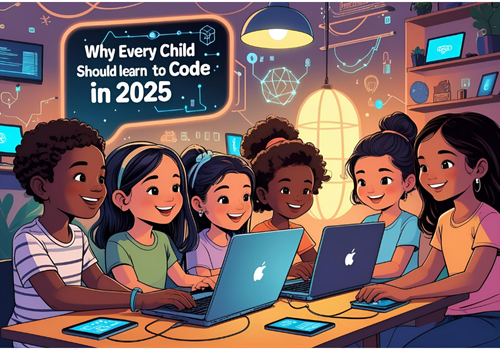Why Every Child Should Learn to Code in 2025

Why Every Child Should Learn to Code in 2025
In today’s world, technology touches every part of our lives—from the way we communicate and learn, to how we play and create. As we move deeper into the digital age, one skill stands out as essential for the next generation: coding.
Gone are the days when coding was just for tech experts or engineers. In 2025, learning to code is becoming as fundamental as reading, writing, and arithmetic. It’s not just about computers—it’s about empowering children to become confident problem-solvers, critical thinkers, and creative innovators.
Coding = Thinking, Not Just Typing
When many people think of coding, they picture long lines of text and complex symbols. But for children, especially those in elementary and middle school, coding is much more visual, interactive, and fun. Platforms like Scratch, Tynker, and Code.org use simple, drag-and-drop building blocks that allow kids to create games, animations, and stories—without typing a single line of code.
In this way, coding becomes a playful introduction to computational thinking—the ability to break down problems, spot patterns, and design logical solutions. These skills are powerful in any subject, from math to music to science.
Why 2025 Is the Perfect Time to Start
The world has changed rapidly in recent years. Technology is no longer a niche field—it’s part of nearly every career and industry. By 2025:
- AI and automation are transforming how we work.
- Digital fluency is a basic requirement in education.
- Creative thinking and tech literacy are top skills sought by employers.
That’s why helping children learn to code early sets them up not just for future jobs, but for life. It gives them a head start in understanding how the digital world works—and how to shape it themselves.
What Coding Teaches Beyond Tech
At Core Code Learning, we’ve seen firsthand how coding empowers kids in surprising ways. Here’s what coding helps children build:
🧠 Logical Thinking
Children learn how to think in steps and sequences, helping them tackle complex problems one piece at a time.
🎨 Creativity
Coding lets kids design their own stories, games, and animations. They’re not just consumers of technology—they become creators.
💪 Resilience
When code doesn’t work, students learn to debug and try again. They build patience, perseverance, and a growth mindset.
🤝 Collaboration
Many coding projects involve teamwork, communication, and sharing ideas—essential life skills for the future.
Coding for Every Age and Stage
At Core Code Learning, we offer age-appropriate coding pathways for students from Grade 1 to Grade 10+. From drag-and-drop platforms to Python, web design, and app development, we meet learners where they are and help them grow at their own pace.
Our curriculum is designed not just to teach tools—but to inspire confidence, curiosity, and a passion for learning.
Final Thoughts: Coding is the New Literacy
In 2025, coding is more than a tech skill—it’s a new form of literacy. Just as we teach kids to read and write so they can communicate and create, we teach coding so they can thrive in a world shaped by technology.
Every child deserves the chance to explore, invent, and understand the digital world around them. Coding gives them the power to do just that.
Ready to Start Your Child’s Coding Journey?
🚀 Book a free trial class with Core Code Learning
🎯 Explore age-based programs for students in Grades 1–10+
💬 Connect with expert instructors who make learning fun and impactful
Because in 2025 and beyond—every child can be a coder.


